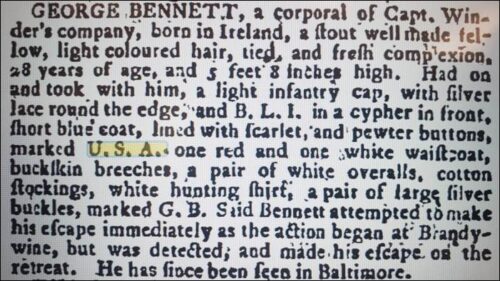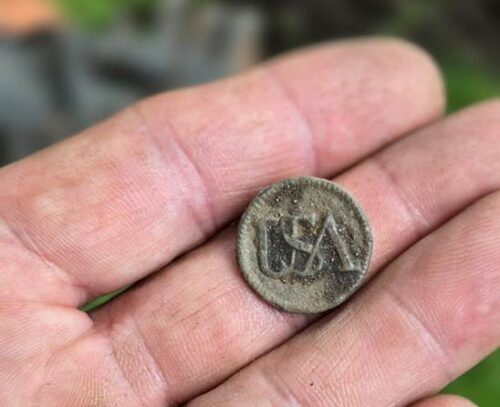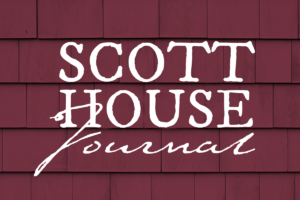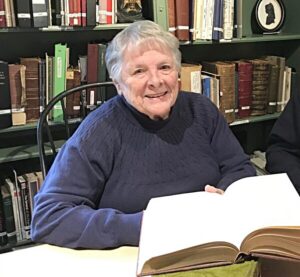The Battle of Ridgefield archaeological project, funded by a National Park Service grant, is a project of the Ridgefield Historical Society, with Heritage Consultants LLC, the professional team charged with exploring and documenting evidence of the battle’s boundaries, engagements and participants. A first phase of this effort was completed in 2022, when documentation and mapping were undertaken.
Now, hands-on archaeological work is the primary focus of the team, which has been working at a variety of locations throughout the battlefield area. Monthly blog posts by team member archaeologist Dr. Samantha Lee provide updates on discoveries.
Recently, while detecting a site related to the Fourth Engagement of the Battle of Ridgefield, a Heritage team member uncovered a pewter USA button. The button was found near a number of dropped American musket balls as well as two impacted American musket balls, indicating that a skirmish possibly occurred there. (The Fourth Engagement was actually several skirmishes of varying sizes that occurred south of the main barricade. These all occurred after the British breached the main barricade and began chasing down Americans attempting to gain high ground on the ridges.)
These pewter buttons were the most common type of Continental button and were worn by privates in the Continental Army. The buttons were typically made of pewter or lead and were cast in molds, sometimes in camps. Examples of unfinished USA buttons have been recovered from refuse pits at Revolutionary War camp sites.
The earliest written evidence for these buttons comes from a remarkable advertisement printed in the Maryland Journal and Baltimore Advertiser on December 9, 1777, seeking information concerning the whereabouts of a man named George Bennett, a corporal serving in the First Maryland Regiment. It claims that Bennett deserted during the retreat from the Battle of Brandywine on September 11, 1777. He was described as wearing a short blue coat with “pewter buttons, marked U.S.A.“ Bennett would have acquired the Continental buttons before the battle that day, making September 11, 1777 the earliest known date for the existence of the buttons.

A deserter ad printed in the December 9, 1777 issue of the Maryland Journal and Baltimore Advertiser.
While the two Continental buttons discovered in Ridgefield so far could be from later encampments, the context in which they were found strongly suggests that they are battle related, and likely associated with the 20 Continental soldiers from the 5th Connecticut Regiment known to have participated in the battle. Additionally, an 1888 article notes that Mr. Linus O. Northrop discovered a lead button with the monogram U.S.A. in relief on his property on Wilton Road W. sometime in the late 1850s. Counting Mr. Northrop’s button, a total of three Continental buttons have been recovered within a half mile of one another in Ridgefield. As far as we know, the Continental buttons found in Ridgefield are the earliest archaeological examples of their kind and push the earliest date for the existence of the USA buttons to at least April of 1777.
The Heritage team is currently metal detecting sites related to Fourth Engagement skirmishes. If any members of the community have any information or oral histories about skirmish sites in the Battle of Ridgefield, we would love to hear from you! Please email [email protected].
The success of this project depends on local property owners giving the Historical Society and Heritage Consultants permission to examine their land. With enough cooperation, crucial artifacts may be uncovered that could resolve some of the remaining mysteries of the Battle. Any artifacts found during the survey will be cataloged and preserved at the Ridgefield Historical Society and shared with the Ridgefield community as tangible reminders of a significant moment in the history of the U.S and Ridgefield.





